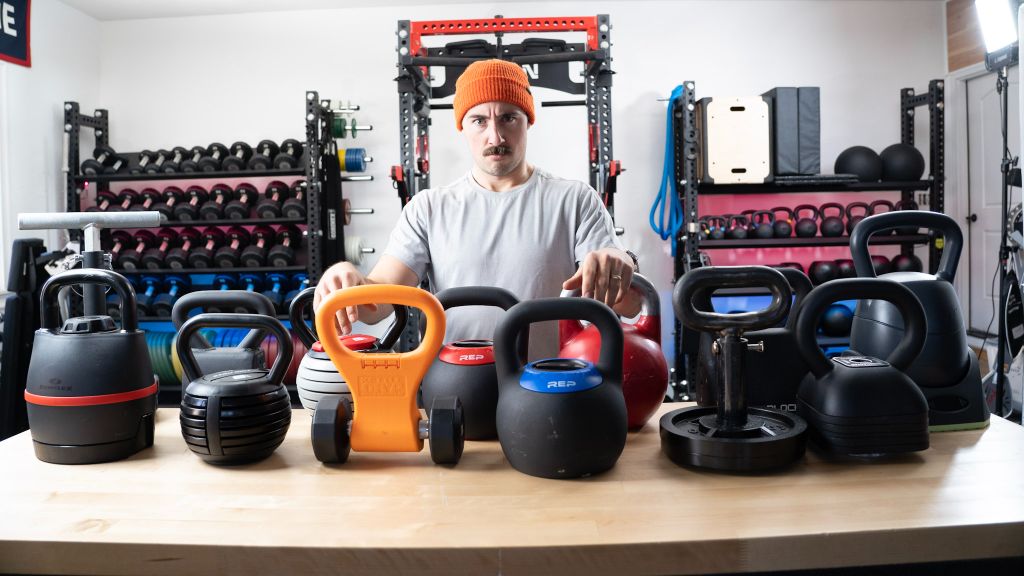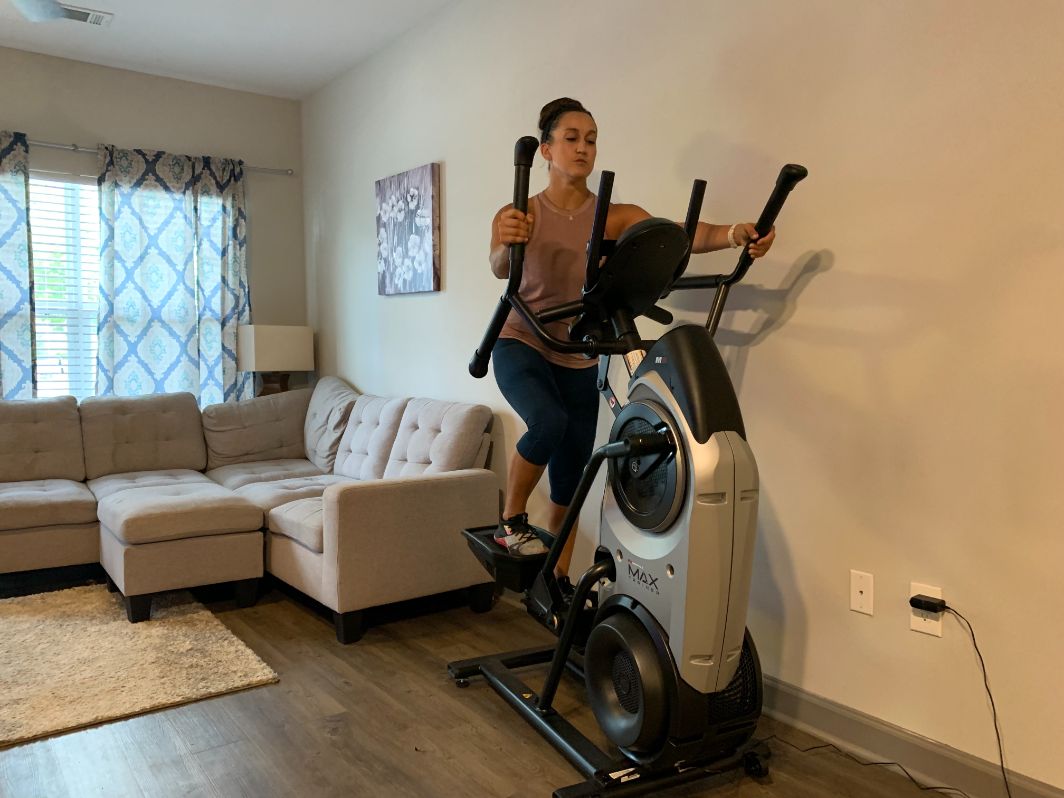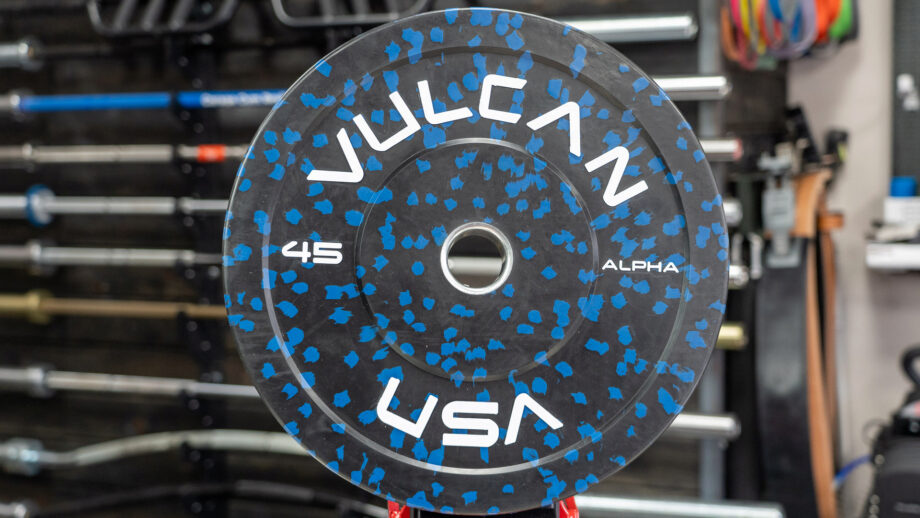Free Weights vs Resistance Bands: Why Both Might Be Hard To Resist For Building Muscle And Enhancing Fitness Performance
Pumping… Elastic? Pumping… Latex? Pumping… Rubber?
While those might not sound as catchy—or “tough” for that matter—as “pumping iron,” we believe elastic bands shouldn’t be approached with such resistance.
Ahead, we “weigh in” on the real differences and similarities between free weights vs resistance bands. Each type of exercise comes with its own unique benefits that are simply irresistible for muscle-building and more!
Free Weights vs Resistance Bands: Key Similarities
The naked eye might question if a heavy iron dumbbell could even share similarities with a lightweight elastic band. But free weights and resistance bands likely have more in common than you think…
Resistance Training Methods
We’ll start with a more obvious similarity: both free weights and resistance bands are resistance training tools. Resistance training, also known as strength training, is any exercise that increases muscle mass and strength.
RELATED: What is Resistance Training?
Cardio and strength training benefit health greatly and should complement one another in a fitness routine. However, strength training is best for increasing strength, building lean muscle mass, and boosting your metabolic rate.
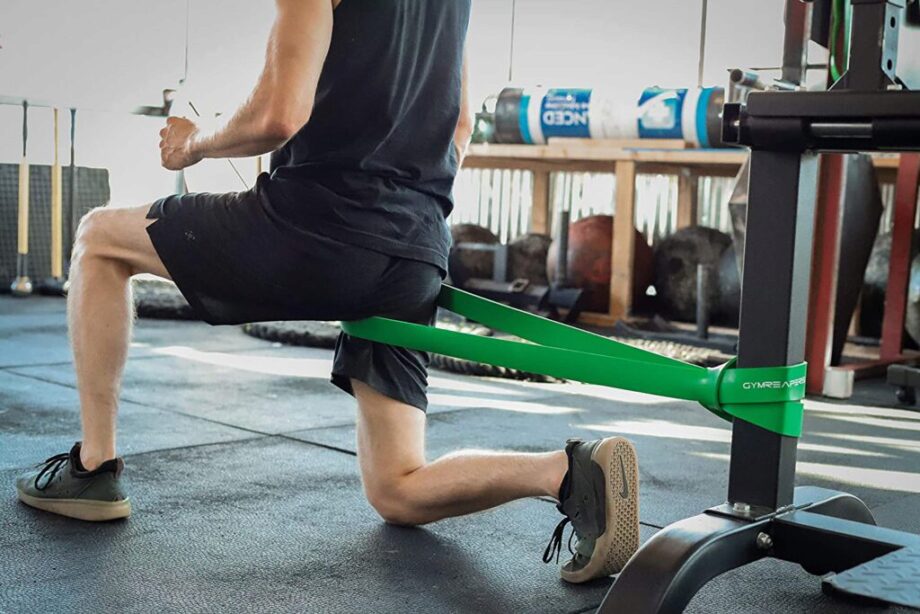
Progressive Overload/Resistance Variables
Simply put, progressive overload means gradually increasing a stimulus in your training and is key for enhancing muscle growth and muscle strength. Similar to progressive overload, progressive resistance1 is a method of increasing the ability of muscles to generate force—or simply increasing the resistance as strength increases.
You can manipulate progressive overload variables—like rest periods, load, repetition, and volume—with both resistance bands and free weights. Unlike weight machines that lock you into a single motion, free weights and resistance bands can be challenged in their full range of motion.
Another progressive overload/resistance variable to build muscle is time under tension (TUT). With TUT, you can slow down the rep of the movement using a resistance band and/or free weight.
Muscle Activating, Building, and Strengthening
So now let’s explicitly weigh in on the likely elephant on the page… Yes, resistance band training CAN activate, build, and strengthen muscle!
The muscle-building and strengthening capabilities of bands should not be so surprising considering the aforementioned similarities of being a resistance training tool that can apply progressive overload/resistance variables. But don’t just take our word for it…
A 2016 meta-analysis published in Clinical Biomechanics2 suggests elastic resistance provides similar muscle activation as isoinertial resistance. Isoinertial exercises maintain constant inertia and are often performed as flywheel training3, which allows eccentric overload and variable resistance throughout the movement.
In a 2017 study4 comparing multi-joint exercises using elastic resistance bands (ERB) and conventional resistance-training equipment (CRE), use of bands shows to be a feasible training method. Despite lower quad activation with band use, researchers suggest the differences between ERB and CRE can be largely eliminated when the bands become elongated in the end ranges of the movements.
A more recent 2019 meta-analysis in SAGE Open Medicine5 supports that elastic band training can prompt similar strength gains to conventional resistance training in various populations, including seniors and people living with fibromyalgia and osteoarthritis.

Various Types Available
Free weights and resistance bands come in various types to suit just about any preferred style of training. Types of free weights include dumbbells, barbells, kettlebells, medicine balls, and sandbags—all of which can be purchased in many weight amounts.
Resistance bands also come in many different fitness flavors, including (mini) loop bands, flat resistance bands, tube resistance bands with handles, and resistance bands for glutes and recovery… Just to name a few. The various types of resistance bands range in weight (and color) based on their created resistance when pulled, often ranging from “extra light” to “extra heavy.”
Trivia time! How much resistance is a resistance band capable of producing? (You’ve gotta keep reading for the impressive answer…)
Portable
While one is obviously more portable than the other (and more on this coming up), resistance bands and free weights are portable no matter which type you choose. Unlike mounted machines, free weights can be transported from their weight rack to the gym floor to wherever you have space for them.
Free Weights vs Resistance Bands: Key Differences
While free weights and resistance bands likely have more in common than you thought, there are some obvious (and not-so-obvious) differences between the two.
Size and Weight
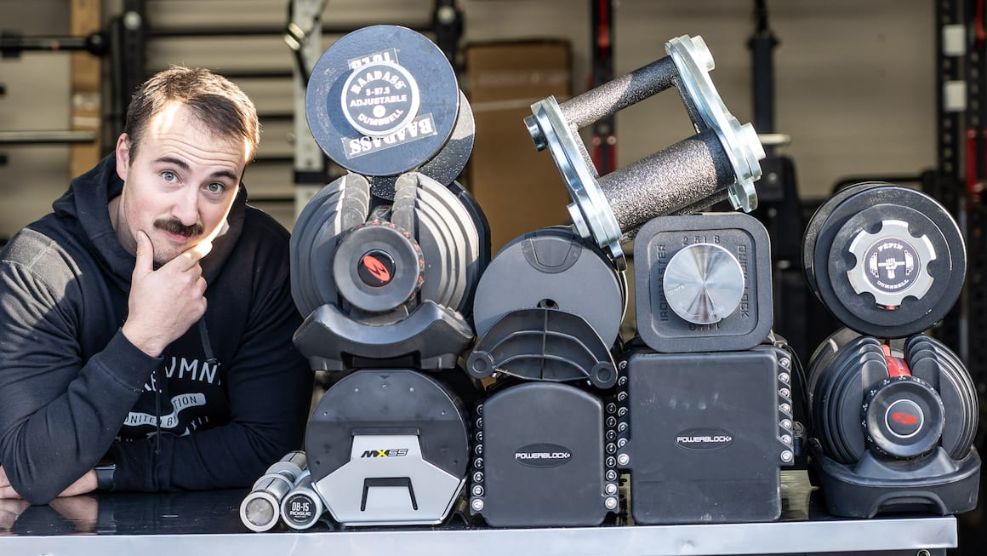
It’s quite obvious the size and weight of free weights and resistance bands separate themselves from one another. Free weights—particularly barbells, dumbbells, and kettlebells often made from steel—are quite bulky and heavy (which is mostly the point of such free weights).
On the other hand, resistance bands are compact and lightweight. An entire set of resistance bands can fit into a small pouch and weigh less than the lightest dumbbell on the market.
Trivia answer time! So, how much resistance is a resistance band capable of producing? Well, the silver Monster Band from Rogue can produce 200 pounds of resistance!
Cost
Budget-friendly dumbbells and other free weights are available to build and expand your ultimate home gym. However, resistance bands tend to be wildly less expensive and provide more fitness bang for your buck.
Some of the best resistance bands on the market cost less than $20 while providing 100 pounds of combined resistance. The cost of free weights mostly depends on the weight, as a pair of 10-pound dumbbells is generally less expensive compared to a 50-pound pair.
Overall, if you want to fill an entire weight rack, you’re looking to spend a prettier penny compared to resistance bands. Also, remember to factor in the cost of a weight rack and home gym flooring, which we recommend installing in the case you happen to drop a free weight.
Resistance and Muscle Loading
Resistance bands and free weights both provide resistance, though how that resistance is created varies. This subsequently impacts how you should position yourself to load the muscle most effectively.
Free weights constantly load muscle by working against gravity6, which means they only provide resistance in the direction of gravity: down. The weight load of free weights is constant—a 20-pound dumbbell will always weigh 20 pounds—and increasing or decreasing the weight requires picking up a different weight size.
Resistance bands create variable resistance through elastic force, loading the muscle with greater resistance the harder you pull. The load of resistance bands often depends on the band’s thickness and how much the band is stretched.
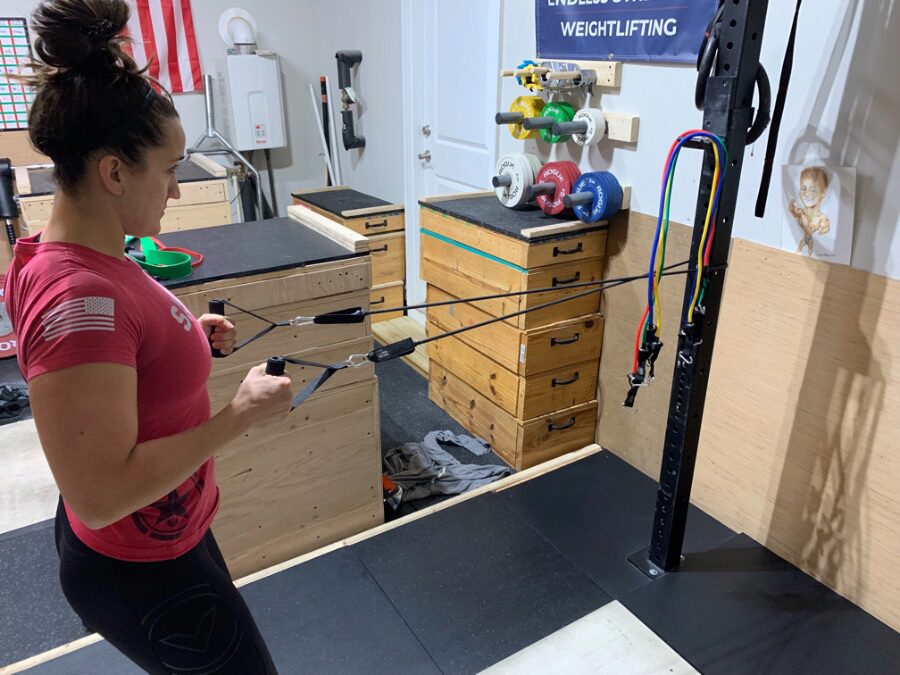
To help you visualize how resistance is created and transferred, think about the movement of a chest press: With free weights, you lay on a bench press and then push the weight up against the downward pull of gravity. Chest pressing a free weight while standing and targeting the chest muscles is next to impossible based on physics.
However, you could effectively press a resistance band and target the chest muscles while standing by anchoring the band. You could hug a band around your back and then press forward using the handles or loops as well. (For more info, read our guide on using resistance bands correctly.)
Functionality
While both functional, resistance bands and free weights are purposeful in their own unique ways. With functional fitness training, free weights often provide resistance to build strength and overall strength. Bodyweight movements like—like push-ups and pull-ups—also incorporate functional stability and balance.
But because resistance bands can assist in pull-ups and other progressions, they can accommodate and enhance functional training in a different way. Resistance bands likewise function as prehab and rehab tools, as they are great for warm-ups and recovering from an injury since they tend to be gentler on the joints.
Benefits of Free Weights
Whether deadlifting a barbell, throwing a sandbag over your shoulders, or chest-pressing dumbbells, free weights are some of the most widely used strength training equipment. Let’s dive into what makes free weights so widely beneficial.
Objective Tracking
Weight lifters tend to have one shared goal: increasing the amount of weight they can lift. Because free weights distinctly mark their weight, unlike most resistance bands, lifters can clearly see how much weight they’re lifting.
A clearly defined weight amount makes it easier to objectively track progressive overload. For instance, if someone’s goal is to increase their overhead press strength by 20 pounds, it’s more concrete and less ambiguous to track a marked free weight over a “heavy” labeled resistance band.

Durable
“You get what you pay for” often rings true when comparing the cost and durability of most free weights. While you’ll likely be forking out more Benjamins on high-quality dumbbells, kettlebells, and other free weights, they’re quite durable and built to last—when cared for, of course.
Balance Training and Stability
Functional fitness training is widely used with one’s own body weight or by adding resistance with free weights. The freedom of each movement, rather than being locked into the movement path of a mounted machine, recruits other muscles for stability.
When stabilizer muscles are actively used and strengthened, you naturally enhance core strength and overall balance. Stability and balance are core components of a balanced fitness regimen and carryover to stronger lifts and better day-to-day movement.
Best for Strength and Lifting Movements
While bands are effective strength-training tools, they can’t be fully applied to the six common movement patterns of free weight workouts:
- Push
- Pull
- Squat
- Hinge
- Lunge
- Carry
Yes, you can position your body to complete a banded lunge and technically carry a resistance band. However, you’re missing out on the true resistance that gravity places on a free weight which means missing out on the true benefits of these movements when performed with intent.
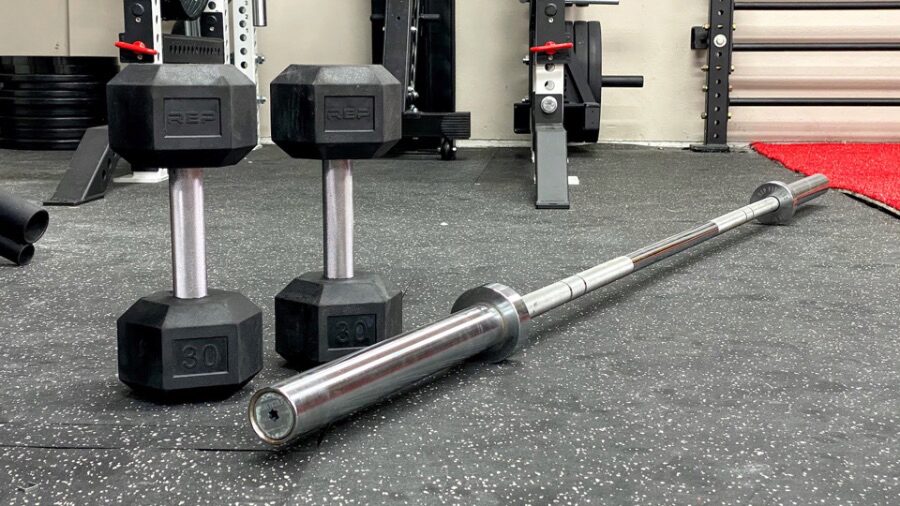
Benefits of Resistance Bands
By now, we hope resistance bands are showing just what they’re capable of regardless of their small (but mighty!) size. Of course, we aren’t trying to dissuade you from using free weights and hope to lessen any resistance you have training with bands.
Budget-Friendly
Resistance bands tend to be much more budget-friendly compared to free weights. The cost makes them especially ideal for beginners wanting to test the waters or simply searching for inexpensive, yet effective fitness options.
Convenient and Portable
If you’re a gym member, both resistance bands and free weights are often conveniently and readily available to use. If you’re looking to build or expand your home gym, each can be purchased online or in-store as well.
But due to their compact and slim size, resistance bands have the upper hand of being the most convenient to transport and store compared to free weights. Resistance bands are ideal for storing in tight spaces and exercising on the go.
Safe to Use
All exercises come with their own set of injury risks, especially if you aren’t warmed up and performing the exercise correctly. Also speaking of warming up, resistance bands are great to avoid that common workout mistake.
Overall, it’s pretty safe to say dropping a 50-pound weight on your foot would be more painful and harmful compared to a less-than-1-pound resistance band. And because you control the resistance produced by the band, you have greater safety control versus trying to press dumbbells heavier than what you were physically ready for—which can greatly increase the risk of injury.
Versatile
Of course, free weights offer versatility, but resistance bands might offer the most fitness variety with just one single, compact band set. And while resistance bands aren’t often the focus of a strength-based program, they can still provide similar muscle activation and growth when applying progressive resistance.
Muscle-building aside, resistance bands are often used to enhance sports performance due to their power-boosting benefits. (You can get these endurance benefits from free weights like slam balls, too.) Bands also come in handy for mobility training as you work on getting deeper stretches.
Physical therapy clinics use free weight and resistance band exercises, particularly on a case-by-case basis. However, bands might be the best option for home-based programs due to their low cost and convenience.
Bands also tend to be lower impact and easier on the joints, which might be a safer fitness option for people rehabbing an injury and older adults. Besides, research from the Journal of Sports Science and Medicine7 encourages functional exercise programs using a resistance band can improve fitness and cognitive performance in healthy older adults.
When to Use Free Weights vs Resistance Bands
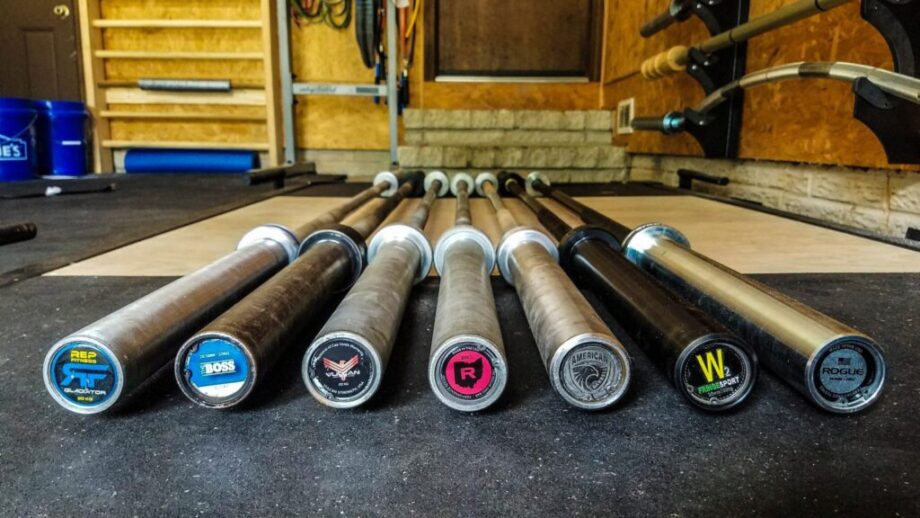
So when should use resistance bands over free weights and vice versa? The answer mostly depends on the exercisers’ fitness levels, goals, and needs.
For Beginners: Resistance Bands
We’re slightly torn on this one, as free weights and resistance bands offer unique advantages for beginners embarking on their fitness journey. But overall, resistance bands might be best suited for beginners.
Before resting our case, we can’t help but mention that marked free weights are likely best for beginners learning how to track workout progress. Especially when first starting with resistance training, tracking based on their rate of perceived exertion (RPE) could be quite challenging.
On the flip side, resistance bands tend to be less intimidating to approach compared to walking up and grabbing a dumbbell in a crowd of seasoned lifters—especially when you’re not confident with the chosen weight. Resistance bands are also more budget-friendly if looking to test out the fitness waters at home.
The type of “best” for beginners is not nearly as important as learning how to properly execute form. Proper form is always the top priority and working with a personal trainer can be extremely beneficial when starting a fitness journey.
For Traveling: Resistance Bands
Have you ever tried to pack up and travel with 100 pounds worth of dumbbells? Unless you’re moving from one garage gym to the next, likely not… Resistance bands for traveling use is a pretty clear answer.
Resistance bands are great for traveling and using for hotel room workouts. Even with just a band or two, you can get in a full-body workout just about anywhere thanks to the varying levels of resistance you can create.

For Small Spaces: Resistance Bands
Adjustable dumbbells are some of the best compact exercise equipment. But if you also want variety, without having to purchase additional gym equipment like a weight bench, resistance bands might just be your best option.
Resistance bands offer bountiful variety, especially if you have an anchor point-which could be as simple as a door. When you’re done with an office or home workout, simply tuck in a drawer, backpack, or another discreet storage spot.
For Cardio: Either
You can get a cardio workout in by revving up the pace of just about any exercise using a free weight or resistance band.
However, the resistance variability of explosive banded exercises and their general safety might just give bands the cardio advantage. (Squat jumping with heavier dumbbells comes with a greater injury risk if the weight flails out of the lifter’s hand…)
On the flip side, using lighter free weights for high-volume sets of 15 or more reps is a fantastic way to elicit a burn in both the lungs and all muscle groups.
For Purely Strength and Weight Training: Free Weights
If you’re looking to mostly gain muscular strength and weight train, well, using free weights is a pretty obvious answer. You can mimic heavy-weight lifts with resistance bands, though they do have an upper limit for maxing out on a deadlift…
Though dumbbells and kettlebells can help you gain strength, we recommend a barbell and enough weight plates to max out on your compound lifts. Resistance bands are also great for accessory work but shouldn’t be the center of a strength-based program.
For the Best Fitness Benefits: Both!
Instead of picking either-or, why not have the best of both worlds? Even if building strength is your focus, resistance bands are still great for accessory work, warm-ups, mobility, and more. If resistance bands are more your speed, don’t be afraid to use free weights when given a safe chance.
You can also literally combine the two for a squat, bicep curl, shoulder press, deadlift, and countless other exercises. As you work through the movement, you’ll feel the effects quickly thanks to the combined weight and constant tension delivered by the free weight and resistance band.
Overall, varying your training with elastic bands and free weights will likely yield the best strength and fitness gains. But at the end of the day, it’s most important to focus on form and stay consistent with training no matter which equipment you choose.
Final Thoughts: Free Weights vs Resistance Bands
Despite their obvious differences in size, both free weights and resistance bands are effective strength-training tools. Progressive overload and resistance variables can be applied to each, including working through a full range of motion and manipulating the load.
Whether you choose free weights or resistance bands is mostly based on your goals and lifestyle, as free weights are best for more seasoned lifters focused on gaining strength. Resistance bands, on the other hand, are ideal for compact spaces and traveling.
You also don’t necessarily HAVE to pick either, either… Resistance bands and free weights can both be included in a balanced fitness regimen and even be used in tandem.
Regardless if you choose to “pump elastic” and/or “pump iron,” stay consistent using them in your training—that’s when the fitness benefits are truly irresistible!
FAQs: Free Weights vs Resistance Bands
What are the advantages of using weights as opposed to resistance bands?
Because weights are quantitatively labeled with their weight amount, using weights offers more objective tracking. Especially when using free weights, lifters can enhance their muscular strength while improving balance and stability.
Can you replace weights with resistance bands?
Weights can be replaced with resistance bands and other resistance training tools. However, whether or not you should replace them depends on various factors.
For one, if your goal is purely to increase your strength-based lifts, we don’t recommend foregoing your barbell or other free weights. But if you’re keeping up with fitness while traveling, resistance bands are the “weigh” to go.
What weight is equivalent to bands?
Band weight mostly depends on the type and thickness of the band. For instance, Rogue’s Monster Bands range from 15 to 200 pounds of resistance. On the other hand, Rogue categorizes their tube resistance bands as “very light” ranging to “super heavy.
References
- Taylor NF, Dodd KJ, Damiano DL. Progressive resistance exercise in physical therapy: a summary of systematic reviews. Phys Ther. 2005;85(11):1208-1223.
- Aboodarda SJ, Page PA, Behm DG. Muscle activation comparisons between elastic and isoinertial resistance: A meta-analysis. Clin Biomech. 2016;39:52-61. doi:10.1016/j.clinbiomech.2016.09.008
- Petré H, Wernstål F, Mattsson CM. Effects of Flywheel Training on Strength-Related Variables: a Meta-analysis. Sports Med Open. 2018;4(1):55. doi:10.1186/s40798-018-0169-5
- Iversen VM, Mork PJ, Vasseljen O, Bergquist R, Fimland MS. Multiple-joint exercises using elastic resistance bands vs. conventional resistance-training equipment: A cross-over study. Eur J Sport Sci. 2017;17(8):973-982. doi:10.1080/17461391.2017.1337229
- Lopes JSS, Machado AF, Micheletti JK, de Almeida AC, Cavina AP, Pastre CM. Effects of training with elastic resistance versus conventional resistance on muscular strength: A systematic review and meta-analysis [published correction appears in SAGE Open Med. 2020 Sep 9;8:2050312120961220]. SAGE Open Med. 2019;7:2050312119831116. doi:10.1177/2050312119831116
- Haff G. Roundtable Discussion: Machines Versus Free Weights. Strength Cond J. 2000;22(6):18-30.
- Ponce-Bravo H, Ponce C, Feriche B, Padial P. Influence of Two Different Exercise Programs on Physical Fitness and Cognitive Performance in Active Older Adults: Functional Resistance-Band Exercises vs. Recreational Oriented Exercises. J Sports Sci Med. 2015;14(4):716-722.


